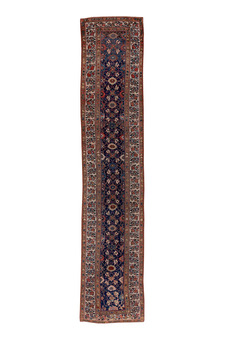Antique runner No. 62528 Kurdistan, ca. 1910 Iran 444 x 91 cm

Larger images (will open in new window)
Please click on the thumbnails below for a larger view
| main view |
Image 2 |
Image 3 |
Image 4 |
Image 5 |
 |
 |
 |
 |
 |
| Image 6 |
Image 7 |
 |
 |
| Item Number: |
62528 |
| Name: |
Kurdistan, ca. 1910 |
| Country of Origin: |
Iran |
| Size: |
444 x 91 cm (runner) |
| Made:
|
ca. 1910 |
| Pile: |
wool |
| Design: |
floral / allover |
| Ground Color: |
dark blue / navy |
| Remarks: |
This is a unique handmade / hand-knotted / traditional oriental carpet
The pile of this carpet is made of wool
This carpet is in good condition despite its age. |
 add to cart
add to cart
More about the provenance Kurdistan, ca. 1910 | Iran
Kurdistan is an ethnical geographic term and not a real state. It describes the area, which is mainly inhabited by Kurds. Mainly it consists of the mountainous borderlands between Iran, Irak, Syria, Turkey reaching into South West Caucasia. The quality and value of the Kurdish rugs can only be assessed according to the individual provenances. In general the Kurdish rug is a rustic, strong woolen rug, mostly with dark color tones, geometric designs and simplified floral patterns.
This is an Oriental nomadic rug. The word "nomad" comes from the Greek word "nemein". Nomads are wandering tribes, shepherds, stockbreeders, or hunters. In the minorly populated areas of Asia and North Africa they move with their herds, all their belongings and their tents to new places constantly. Many states already tried to make them settle down with various success. Mostly it is the women of the tribes which contribute to the family's income with their carpet knotting and weaving while the men breed stock or go hunting. But due to the circumstances of nomadic life the carpet production often lacks regularity and precision in form and design, which actually adds to their originality and makes them even more popular. The wool is mostly dyed with vegetable dyes.

